Greenkeeping and Golf Academy

One of the country's best known players, Rory McIlroy, opened the facility back in 2009, which is referred to as the 'Greenkeeping and Golf Academy' and is situated at CAFRE's Greenmount Campus near Antrim town.
The training facility at the academy includes a three-hole golf course that extends to 700m. The three holes include a dog-leg par 4 first over 300m, a short par 3 second over 130m with a lateral water hazard, and the final par 4 over 270m.
Looking after this course is an important task and falls under the remit of Stuart Nixon, who is the golf course manager as well as an instructor and head greenkeeper.
Stuart's greenkeeping CV includes his ten year stint as head greenkeeper at the college. Stuart picks up the story: "I joined Greenmount in April 1999 as a greenkeeper, a post I undertook for ten years, until I was promoted to golf course manager and instructor in December 2009."
Stuart has various responsibilities at the college, including managing a 170 strong machinery and equipment portfolio.
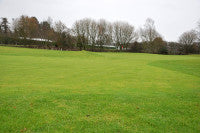
The college's golf course and two sports pitches are maintained by two full time greenkeepers, and assisted by Golfing Union of Ireland sponsored cadets. The newest part of the golf course was constructed in 2005. The greens are approximately 500 square metres, each constructed to USGA specification. Tee boxes are constructed with fifty percent sand and fifty percent sandy loam, both being covered by a fully automatic irrigation system.
The greens are tined in April with 12mm tines; topdressed and direct seeded using Barenbrug Bar 2 and repeated again in August.
Stuart said: "We also aim to carry out sand injection with a Graden machine in all greens every August to a depth of 30mm. Greens are tined with micro tines throughout the year."
"We carry out regular topdressing throughout the season, aiming for once a week/fortnight depending on weather conditions and staffing levels. Regular grooming and brushing is ongoing, dependent on the time of year and ground conditions."
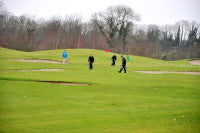
"This is after testing and evaluating various models, taking readings using a stimpmeter, Clegg impact hammer and greens tester."
"We do not use temporary greens on the course. Greens are closed until the frost lifts. On some occasions, due to limited air flow and shading from the low winter sun, certain greens may remain under a cover of frost all day."
"Tee boxes are cut at a height of 13mm, boxed throughout the year. We cut them four times per week in the summer and as required throughout the winter, but usually once a week to maintain presentation. Tees and approaches generally get the same maintenance as the greens with regards to aeration, topdressing switching and brushing."

Topdressing of approximately 160 tonnes is applied to the four fairways throughout the year, with verti-draining being carried out approximately five times.
In the past, the range fairway gave problems with standing water so, last year, the decision was taken to gravel band the fairway at 400mm centres, totalling 40,000 linear metres of secondary drainage.
Stuart added: "I try to manage the course with sustainability in mind, trying to limit fertiliser applications and chemical applications as much as possible but, on occasions, disease control measures are a necessity."
"Fertiliser is applied to greens, tees and fairways after soil samples have been taken, and a fertiliser programme is drawn up, tailored to correct deficiencies whilst trying to avoid flushes so that we can ensure good playability of the surfaces."
"A mixture of liquid and granular feeds is applied, along with wetting agents, dew clears and pH buffers. Disease control is kept to a minimum, possibly only spraying for fusarium five times in the last three years."
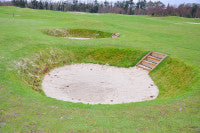
"The fairway mower will be parked up and the tees mower will cut fairways to limit weight. Greens and tee boxes will be hand cut, which is good for presentation."
"Presentation is of the upmost importance, which I stress to the cadets to take their time and produce a quality product that they are proud to say they worked on."
When it comes to machinery, the majority of the equipment is serviced by a local contractor with greens staff carrying out minor repairs.
"From a teaching perspective, we try to keep as modern a fleet as possible which is difficult at times to balance," said Stuart. "We try to weigh up whether to replace a machine or to hold on to it for another couple of years. In reality, we could have a five year old machine and only having 500 hours on the clock potentially being replaced."
"From time to time, a piece of equipment may have to be hired in to undertake work, such as excavators or specialist pieces of kit like the Graden sand injector."

"At CAFRE, our greenkeeper numbers are at a high, which is good to see the value which local clubs put on staff training."
Stuart has quite a good CV when it comes to greenkeeping, as he explained. "I started my greenkeeping career in 1992 at Fortwilliam Golf Club in Belfast, under Michael O'Neill. This trainee post included attending Greenmount Campus on a day release basis, undertaking a level one qualification in Amenity Horticulture, which lasted one year."
"After my year's work placement, I knew greenkeeping was all I wanted to do, but was unable to secure a full-time job. I then took the option of studying for the National Certificate in Horticulture at Greenmount Campus. This course gave me a good knowledge of plants, soils science, landscape construction and machinery use. On completion of my National Certificate, I was able to secure a full-time post at Massereene Golf Club in Antrim."
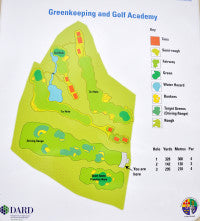
"I worked there for two enjoyable years, during which time I completed my Greenkeeping Level 2 qualification. At Massereene, I carried out a wide range of tasks including mowing, tee construction, bunker construction, renovation and repair, along with a large amount of machinery maintenance as we did this all in-house.
"In May 1996, my old deputy at Fortwilliam retired and I was offered the position of deputy course manager under Michael O'Neill. Michael believed strongly in greenkeeper training and enrolled all new staff on the Level 2 programme at CAFRE. As this was a deputy's position, Michael enrolled me on the Level 3 Sportsturf Programme, which I completed in 1999."
"My deputy post at Fortwilliam involved assisting in running a 110 acre parkland course with a greenkeeping staff of seven. This was a big step up at the age of 20 and gave me skills and experience which have served me well in my career so far. I made the decision in 1999 to leave Fortwilliam for Greenmount Campus."
"Greenmount gave me the experience of working on football and rugby pitches and also assisting in student practicals which interested me. I have enjoyed it so much that I am still here, sixteen years later."
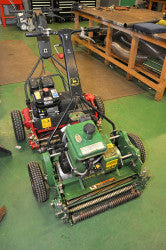
Toro 6500 Reelmaster
Toro 3100 Sidewinder
John Deere 2242 greens mower
John Deere 3245c rotary mower
Jacobsen Greens King
Saxon L56 Greens Mowers x 2
John Deere 22 pedestrian greens mower (approximately 20 years old)
John Deere 1200A bunker rake
John Deere Gator
Kubota L5040 tractor
Kubota G26 garden tractor
Kubota RTV 900
Kubota E2230 compact tractor
Greentek cassette aystem
Saxon triple mower
Avant Multi Tool materials handler
Ultra Spreader topdresser 1.5t
Ultra Spreader topdresser 4.5t
Ultra Spreader high tip trailer
Sisis Veemo
Charterhouse 7416 Verti-Drain
Laser linemarker
Ryan Mataway overseeder
Groundsman Turf Aerator x 3
Groundsman Core Collector
Groundsman Turf Cutter
Toro Flail
Eric Hunter Cylinder grinder
Hardi 200L Sprayer
Gambetti 400L Sprayer

Greenkeeping skills are taught at the Greenmount campus of CAFRE, and an important aspect of the training is that it is supported by excellent resources, which includes the Greenkeeping and Golf Academy (GGA) at Greenmount and Golfing Union of Ireland (GUI)
The students, at all levels of study, have access to modern equipment and excellent playing surfaces, along with a dedicated team of skilled tutors and staff.
The GGA comprises a purpose-built reception and training area, driving range, short game practice area (putting and bunker shots) as well as the three-hole course.
This facility, plus the existing sports turf surfaces for football, rugby and Gaelic football are maintained by the staff and trainees at the campus. Specialised vocational training in greenkeeping and sports turf management is offered at a number of levels.
The provision for greenkeepers starts at Level 2, which is often described as the skilled operator level. The main course programme involves a two-year duration apprenticeship, at the end of which the trainee is a fully qualified greenkeeper and has additional industry-recognised training certificates to his or her name; the most recognisable of these additional qualifications are probably the pesticides application modules required by law.
This apprenticeship course is aimed at young entrants to the industry, who are working at a club and who would benefit from receiving training while they are gaining experience on the greens and tees at work.
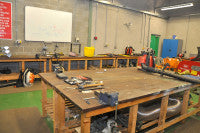
The course covers all the practical skills and tasks associated with greenkeeping duties, and success depends very much on the individual candidate's ability to perform these skilled tasks to an industry standard, both in terms of work rate and quality of finish.
Running parallel to the apprenticeship is the unique GUI Greenkeeping Cadetship programme. The GUI supports a number of bursaries each year for young people wishing to enter the industry, allowing them to train up on a full-time basis on the academy course over one academic year.
On completion, the cadets go straight into the industry as trained cadets. They work alongside the regular greens staff at the college, but spend two days per week studying for the Level 2 Diploma. This means they cover the course over one year, rather than two.
A more recent development for the college is the creation of Higher Education Cadetships, where a successful work-placement student from the Level 5 Foundation Degree can undertake the cadetship programme over a six month period, beginning in July each year.
This additional qualification ideally complements the Foundation Degree, but it does require a sustained intensive period of learning for the cadets.
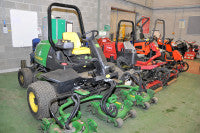
This day-release course, which also takes two years to complete, is most suitable for newly appointed or assistant superintendents who wish to enhance their technical and managerial skills, with units covering construction and performance standards for sports turf for example.
This level of study also introduces students to research, investigating issues such as drainage improvement and developing plans and specifications that they can use in their own work place.
Chris McArthur is currently studying on this course whilst working for Portstewart Golf Course. Chris has been selected as the representative for Scotland and Northern Ireland on the inaugural John Deere TPC Sawgrass Volunteer Programme.
CAFRE also offers courses in Higher Education, either on a full-time basis, leading to a Foundation Degree (FDSc), or on a part-time basis, usually leading to a Certificate in Higher Education (CHE). This course takes the individual's learning that bit further, requiring the student to demonstrate the ability to research issues such as pest and diseases and to develop management control programmes for implementation on the golf course.

The Foundation Degree course encourages the students to be independent learners, to try and develop their skills of critical thinking and inquiry.
Both Level 3 and Foundation degree courses require the student to carry out an investigative project on a work-related topic. In the context of golf greenkeeping, most students opt for field based research topics rather than survey collection and analysis type projects.
The design of the greenkeeping and golf facility means it can facilitate a number of such field trial projects simultaneously, without incurring the wrath of the club golfer and away from the potentially disruptive influences of a user driven maintenance programme.
Four putting green surfaces, each sown out with their distinctive mixes i.e. Creeping Bent, Dwarf Rye, all fescue, and traditional 80:20 Bent/Fescue have provided platforms for students to carry out research on a number of topics.
More general topics, for example, setting criteria for bunker sand selection, comparisons of the effectiveness of fairway drainage systems, reseeding techniques and the efficacy of slow and controlled release fertilisers have all been investigated and the results relayed back by the students for adoption in their home courses.
Another feature of the academy design is the inclusion of zones sown out with turf species not commonly encountered in the UK - Rhizomatous Tall Fescue and Deschampsia.
Incorporation of these species into tee boxes or fairway areas gives students an insight into different management techniques for these grasses.
Given that not all the graduates go into the mainstream course management sector, and that a proportion end up working in the fairly buoyant Ireland sports turf construction industry, some experience of design and construction are seen as necessary on the courses.
Level 3 and Foundation Degree students have designed, project managed and physically constructed a new putting green for the golf academy, sponsored by GUI and, similarly, have been closely involved in remodelling a range of revetted bunkers which are integral to the short game practice area.
The venue also plays host, from time to time, to the wider sports turf industry, providing the trade with a recognised focal point and ideal demonstration arena for seminars and show days.
